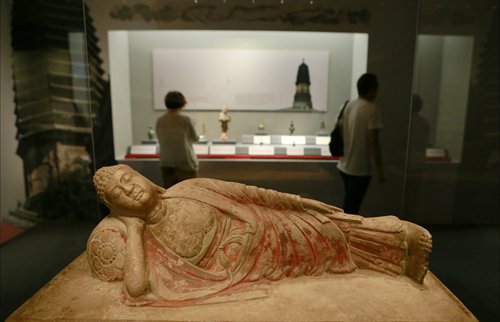
(Photo: Global Times)
The Khitan people, an ancient nomadic group that once ruled northern China from the 10th to the 13th centuries but gradually fell apart as an ethnic group after the fall of the empire, still remain a mystery to many modern history lovers. A new exhibition that kicked off at Beijing's Capital Museum on Thursday may help to provide some insight into the lesser-known history and culture of this group and the Khitan-led Liao Dynasty (916-1125).
Co-organized by Beijing's Capital Museum and the Inner Mongolia Museum, The Capital Cities of the Liao Dynasty exhibition puts on display some 270 relics from museums and archaeological institutions in North China's Inner Mongolia Autonomous Region, Beijing and Northeast China's Liaoning Province - locations where four of the Liao Dynasty's five capital cities were once located.
To better control the territory they held during the Liao Dynasty, the Khitan regime established five capital cities after they claimed power: Upper Capital (today's Lindong county in Inner Mongolia Autonomous Region), East Capital (today's Liaoyang city in Liaoning Province), West Capital (today's Datong city in North China's Shanxi Province), South Capital (today's Beijing) and Central Capital (today's Ningcheng county in the Inner Mongolia Autonomous Region).
While a majority of the show's exhibits are from Inner Mongolia, where two of the capital cities were located, a large number of the items are from the Capital Museum collection and were unearthed from the tombs of Liao officials in southern and western Beijing during the 1960s and 1980s.
Some 70 percent of the show's exhibits, which range from gold accessories to ancient frescos, are national-level relics, the organizers noted at Thursday's opening ceremony.
Divided into five sections, the show also provides explanatory pictures and videos alongside the exhibits that include horse bridles decorated with jewelry and circular-shaped porcelain vases.
Two pottery figures of a man and a woman dressed in traditional Khitan clothing unearthed from a Liao burial site gives visitors an idea about what the northern nomads looked like.
"In terms of race, the Khitan people were Mongoloid, a group which often has protruding cheek bones," Chen Yongzhi, head of the Inner Mongolia Museum, told press during a guided tour of the exhibition.
As to what happened to this ethnic group after the Liao Dynasty came to an end, historians believe that a branch of them merged with the Mongols of Inner Mongolia while another branch moved eastward to live in Northeast China. The Daur people living in Northeast China today are believed to be the descendants of the Khitan.
At the exhibition, an about 40-centimer-high gold crown, a number of gold masks, gold containers and a series of sophisticatedly designed rings decorated with precious jewelry such as marble and pearl immediately attracted many visitors' attention.
The Liao people's high demand for gold items, supported by the dynasty's booming metal smelting industry, was directly connected with their burial traditions.
"Archaeologists often find that the owners of Liao tombs were buried wearing many gold accessories. For instance, one Liao princess was wearing a total of eleven gold rings on one hand, which indicates that the Liao people had a luxurious burial tradition," Chen said.
The exhibition not only explores the Liao people's traditions, but also tries to examine foreign influences on the northern empire.
Aside from gold items, the exhibition also showcases a series of delicate glass containers, which Chen pointed out could be "evidence of the ancient Prairie Silk Road" that connected the northern empire with foreign countries.
"Glass artifacts were obviously imported goods during that period, very likely from the West," Chen said.
Moreover, Chen said the fact that a collection of the dynasties' jade accessories as well as accessory containers shown at the exhibition feature Central Asian and Indo-European styles also suggests a possible connection between the Liao Dynasty and countries in those areas.
The exhibition is scheduled to run until December 9.


